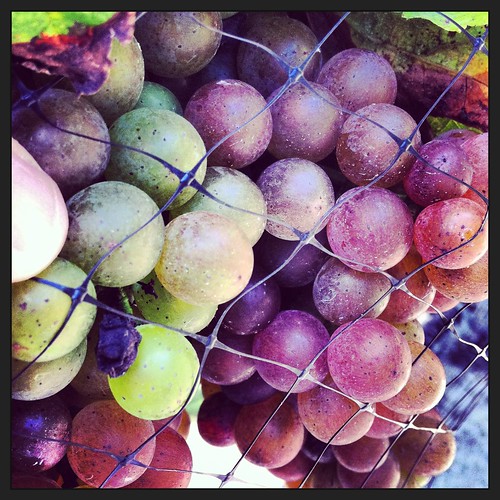
The 2013 grape harvest in Ontario, aside from icewine and those really, really late pickers (Stratus comes to mind), is safely in tanks and waiting to be sorted and barreled and whatever else needs to be done to fermented grapes to make great wine.
It was as about as crazy a vintage as I can remember with Mother Nature throwing every trick in her book at growers. More than any other vintage in recent memory, 2013 was for the skilled grower and winemaker to come together to overcome the pitfalls of the season.
And there were many obstacles in the way.
A cool spring put the vintage well behind the eight-ball making canopy management, fruit thinning, leaf pulling and crop thinning a chess game just to catch up. Add to that some crazy wet weather coupled with high heat mid-summer and wineries were scrambling to stave off downy mildew and botrytis in the vineyard.

A solid spray program to keep disease off the vines was needed and constant application of organic methods was needed for sustainable growers.
Thankfully, the last few weeks of September and early October warmed up to give grapes the extra oomph they needed to fully ripen if picked before or in between some of troubling rain episodes that flooded Ontario more than a few times.
The verdict seems to be a nice vintage for Pinot Noir, Chardonnay, Riesling, Gamay and aromatic whites. Some of the Bordeaux reds provided much angst, especially Cabernet Sauvignon. I know of at least one winery that designated all its Cab Sauv to icewine and many others who won’t be making their top meritage blends or reserve Cabs.
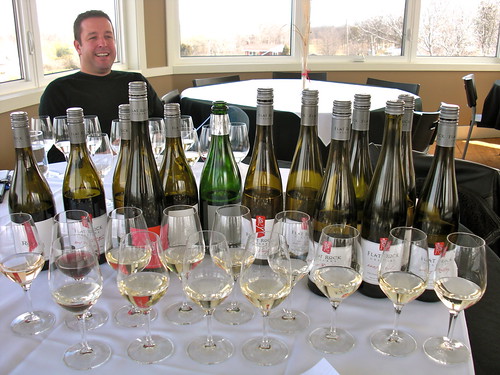
Calling the vintage in Ontario good or bad is a mug’s game. Ed Madronich, owner of Flat Rock Cellars on the Twenty Mile Bench in Niagara, bristles whenever someone (like me!) assesses and rates a vintage in Niagara or Ontario.
 “Why do we always talk about Bordeaux varieties,” he says, referring to the highly rated vintages of 2012, 2010, 2007 etc., all vintages that were highly rated because Merlot, Cabernet Sauvignon and Cabernet Franc ripened beautifully.
“Why do we always talk about Bordeaux varieties,” he says, referring to the highly rated vintages of 2012, 2010, 2007 etc., all vintages that were highly rated because Merlot, Cabernet Sauvignon and Cabernet Franc ripened beautifully.
Madronich argues that vintages such as 2009, 2011 and 2008 were as good or better for what Niagara grows best — Pinot Noir, Chardonnay and Riesling.
“The thing about Niagara,” Madronich says, “is every vintage is different. You just have to pick the right grapes.
“For me, it’s about balance, taking what Mother Nature gives you and not messing it up.”
He’s bullish on the 2013 vintage.
“I think it’s going to be a very good Pinot year, a good Chardonnay year and a very good Riesling year,” he says.
I will be giving a vintage assessment (sorry, Ed!) in another post once I have collected some more data. For now, here’s what a cross-section of Ontario winemakers and winery principals have to say about the 2013 vintage and the wines that will be made from those grapes. As a further note, just after this was posted, the first icewine grapes of the year were picked on Saturday, Nov. 23. By all accounts, Vineland Estate was first out of the gate.
•••
Kevin Panagapka, owner/winemaker 2027 Cellars, Niagara

“I’m pretty excited about this vintage. Colour in the Pinot Noir looks great, acid/sugar ratio with Pinot and Chard is perfect for well balanced wines. Not too sure about the Bordeaux varietals I doubt without a lot of vineyard work they would get the optimal phenolic ripeness. Although, not my expertise.”
•••
Paul Speck, co-owner of Henry of Pelham,
Short Hills Bench, Niagara
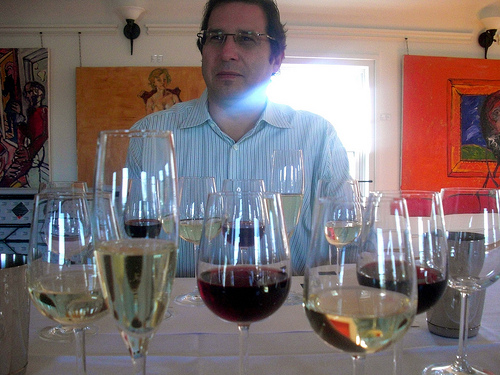
Speck explains in the CBC radio interview that the 2013 harvest was more normal, coming off the extraordinary 2012 vintage. While there were challenges in the vineyard, he explains, the crop had some highlights.
To hear that interview, click here.
•••
Sebastien Jacquey, winemaker at
Le Clos Jordanne, Jordan, Niagara
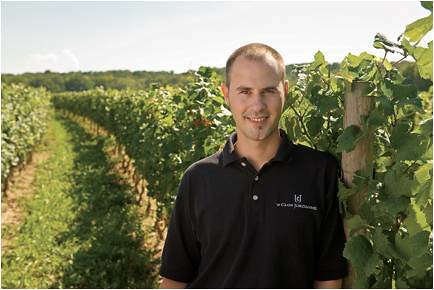
“I think these wines will remain fresh and minerally but with good concentration and a ripe flavour profile. I found 2013 to be a cool vintage with a long ripening period for both Pinot Noir and Chardonnay. I started (picking) with Pinot Noir on Sept. 12 and finished with the last lot of Claystone Terrace (Vineyard) Chardonnay on Oct. 11. Despite a bit of disease pressure, I feel that the wines are well balanced overall. The Pinots have great colour, a fresh palate and a pleasant structure. The Chardonnay displays ripe aromas, great minerality and nice texture. I think our wines will remain fresh and minerally but with good concentration and a ripe flavour profile.”
•••
Jeff Aubry, president of Coyote’s Run Winery,
Niagara-on-the-Lake

“As of today (Nov. 6), the harvest is now done.
It was a challenging season, without a doubt. Hot, cold, wet, dry … any given week had all of these. Layer on the vicious downy mildew outbreak, plus rumours of unwelcome guests (i.e. lady bugs) … things could have been very disappointing. “But that wasn’t the case. In fact, we are looking at great year both in terms of quality and quantity. The last few weeks of Sept. and the first week of October were perfect in terms of weather, and the Pinot Noir, Pinot Gris, and Chardonnay we harvested was extraordinary.
“Fantastic aromas and flavours, particularly on the whites. Syrah was next — and it surprised us all. Despite the cool turn in weather, the Syrah was amazing. Riesling soon followed — great acidity and aromas.
“Finally, in the first week of November, we brought in the Bordeaux varieties. Again, we were fearful — the weather in the preceding three weeks was not exactly ideal. But as it turned out, the Bordeaux grapes were quite good, with the Black Paw (Vineyard) Cabernet Sauvignon being the standout.
“All in all, 2013 is going to produce some very fine wines.”
•••
Curtis Fielding, owner of Fielding Estate Winery,
Beamsville Bench, Niagara
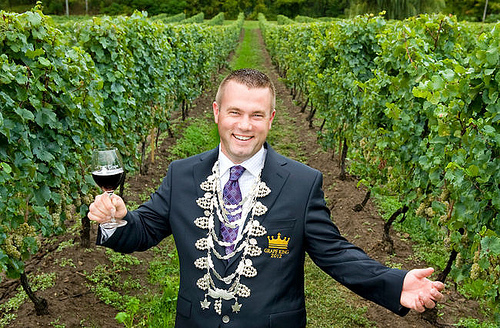
“Here’s my two cents on the 2013 grape harvest.
“2013 was an interesting Vintage to say the least. We had a later start to the growing season with the cooler temperatures in the spring compared to 2012 when we had the huge risk of spring frost damage and we were running the wind machines 24/7 to try and protect the advanced shoots.
“2012 spoiled us with a perfect growing year, 2013 was a kick in the ass to make sure we weren’t getting lazy.
“Obviously with the amount of moisture and the temperature fluctuations we had over the summer proved to be challenging in the vineyard and you really needed to be on your spray program. We worked closely with our vineyard crew on canopy management, fruit thinning, leaf pulling and crop thinning to try and balance our white varieties and further reduce yield in our reds to give them a chance at ripening.
“Overall from what Richie (winemaker, Roberts) and Kristen (Banders) aka ‘The Winemakers’ have said they are happy with the aromatic whites, with Riesling and Viognier being the shining stars and Gamay really showing nicely this early in the game. Time will tell on the other red varieties as they are still in tank fermenting.”
•••
Bruce Nicholson, winemaker at Inniskillin, Niagara-on-the-Lake
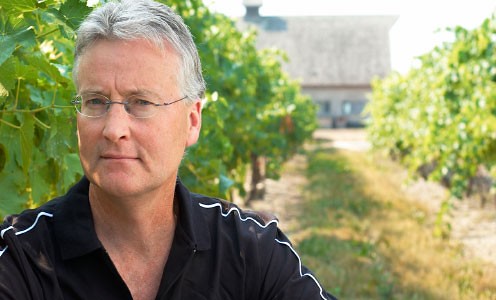
Inniskillin Niagara Estate Winemaker Bruce Nicholson finds his aromatic whites are looking very good with typical varietal aroma and fruit characteristics. He believes his Pinot Noir and Merlot are very promising and is equally optimistic about the Shiraz and Bordeaux reds. He is also excited about the strong possibility of producing his first botrytis affected Viognier from the Brae Burn Winery Estate Vineyard.
•••
Marco Piccoli, Jackson-Triggs winemaker, Niagara-on-the-Lake
 Jackson-Triggs Niagara Estate Winemaker Marco Piccoli started harvest as early as Sept. 6 with his sparkling base Chardonnay and Pinot Noir at the Winery Estate Vineyard. The quality was very good with clean fruit, showing no disease or breakdown after having experienced optimal ripening conditions.
Jackson-Triggs Niagara Estate Winemaker Marco Piccoli started harvest as early as Sept. 6 with his sparkling base Chardonnay and Pinot Noir at the Winery Estate Vineyard. The quality was very good with clean fruit, showing no disease or breakdown after having experienced optimal ripening conditions.
The quality of the Sauvignon Blanc was also good with very little breakdown and zero botrytis. Overall, the grapes were very healthy this year. Pinot Noir and Merlot showed good phenological ripeness across the region from the Bench to Niagara on the Lake and this has resulted in good colour extraction and tannins.
Marco’s biggest challenges were the Cabernets and Syrah, with some late season hang time enabling fruit to mature. In general, the resulting wines are displaying good concentration and structure.
The Cane Cut project really did made a significant difference with the Cabernet Franc and Cabernet Sauvignon, bringing them in at over 23.3 Brix average against an average of 21.5 from all other growers.
•••
Harald Thiel, owner/vigneron, Hidden Bench Winery,
Beamsville Bench
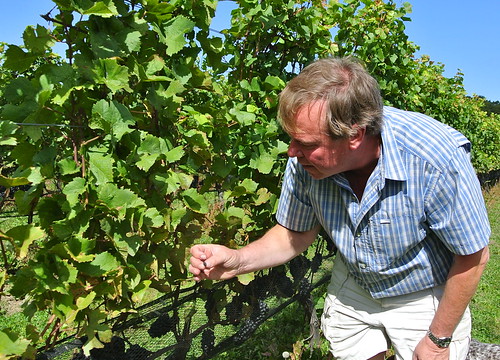
“Looks like a good to great Pinot Noir, Riesling and Chardonnay year. Early Bordeaux varietals (Merlot and Malbec will be good) Cab Franc and Cab Sauvignon could be challenging depending on crop load and location. Early crop thinning/ balancing that we practice at HB will have really enhanced quality in a year like this.”
•••
Michele Bosc, marketing director,
Chateau des Charmes Estate Winery, St. Davids, Niagara

“2013 growing season was an interesting roller coaster ride. Early summer was wet and cool, more like spring. We found ourselves 2-3 weeks behind the norm.
“However, we use July 1 as a benchmark and look to have the vine canopy at the top trellis wire, which it was. But then a cool summer slowed the progress.
“The actual harvest began for us on Sept. 20, 1-2 weeks later than the average. We were all surprised at how well the grapes matured late in the season thanks to a warm, dry September.
“White varieties were coming in exactly how ripe we like them while the early reds were near ideal. For example, Merlot from our Paul Bosc Estate Vineyard was picked at 24.5º Brix.
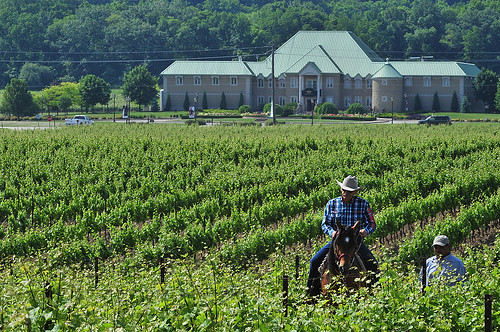
“The Cabernet Franc and Cabernet Sauvignon didn’t fare quite as well. Look for declassifications from marginal vineyard sites. An interesting phenomenon that may well be the defining feature of the 2013 vintage was the higher than normal amount of botrytis, both good and bad. The picking window on many varieties was much smaller than normal due to rot; one day the grapes were clean, the next they were breaking down. You had to be hyper-vigilant.
“This year our crew did more berry selection in the vineyard in the days just before a block was to harvested than in recent memory. Yes, this work is all done by hand thus very expensive but it’s absolutely necessary to extract the best quality fruit from our vineyards.
“We should see some delicious, clean wines from 2013 among those producers who were ruthless in discarding rot-affected grapes.
Today (Nov. 21) is Nouveau release day and I think our Generation Seven #JeSuisArrivé is a terrific example of what can be achieved in 2013; nice balance with warm spice and upfront black berry and strawberry notes.
•••
Dan Sullivan, owner/winemaker Rosehall Run,
Prince Edward County
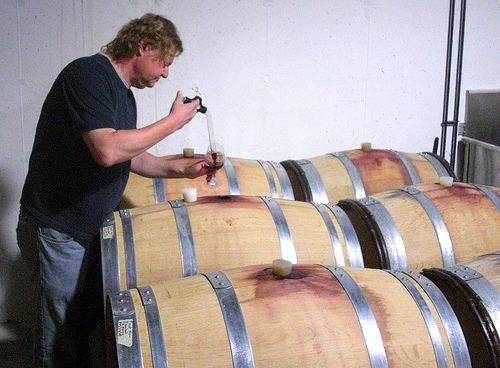
“We just finished our pick at Rosehall Run on Saturday Oct. 12 bringing in the last 2.1 tonnes of Chardonnay from our South Block.
“Although the year started late with a budbreak 10-14 days later than 2012 the season really picked up speed and the generally glorious weather over the last month. The chestnut ‘September makes the vintage’ rings especially true in 2013.
“A humid summer put constant pressure on vineyards particularly for downy mildew and botrytis. Attention to canopy management and disease scouting were critical to getting the fruit to maturity.
“The crop was a little higher than historical averages with Pinot at 1.7-2.5 tonnes/acre depending on the clone and site and Chardonnay at 2-3 tonnes/acre.
“The great weather in the latter half of summer and into early fall pushed sugars to good levels and maturity to optimum. A couple of September downpours however, kept them from going off the charts and forced our hand to pick. The rain on Sept. 22 was a particularly definitive moment for Pinot Noir with our Pinot harvest really kicking in shortly after Sept. 25 ahead of breakdown in our younger west block.
“Heavy morning dew due to cool nights were a double edged sword as botrytis was a minor irritant with some picks reduced by 5-15% through field triage. On the flipside, skins were thick and well coloured and there was brilliant acidity from the cool nights still left in the fruit.
“Although I’m a bit reluctant to make bold predictions at this early stage it is fair to say we expect the 2013 vintage to be very good to excellent. Our Chardonnay and Pinot 667 clone in particular, are some of the best I’ve seen in my 10 crushes at Rosehall Run.
•••
Bruno Francois, winemaker/co-owner
The Old Third, Prince Edward County

“The cold wet spring, which started somewhat late, caused mildew pressure, which had to be kept under control. However, not long after flowering, the skies parted. Lots and lots of sunshine interspersed with a day of rain here and there just when it was needed.
“No drought. The sunny weather continued right into October when we harvested the cab franc. Absolutely perfect for viticulture. To put it into perspective, the 2010 harvest was started on Sept. 6 for the pinot noir. In 2013 we started Sept 8.
A one liner tagline would be something like: Terrible spring but superb summer and fall — finest yet.”
•••
Vintage Report from VQA Ontario for 2013, including Niagara,
Lake Erie North Shore, and Prince Edward County
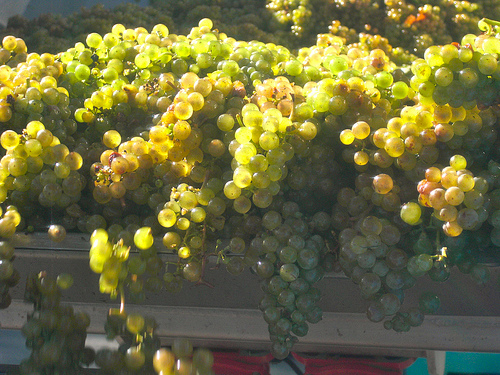
Conditions
Weather conditions during the 2013 season were quite variable in all of the major wine regions but on average, the temperatures were close to normal and precipitation ranged from normal to a bit wetter than normal.
January and February were relatively mild presenting limited opportunities for the Icewine harvest. Spring was cool and wet ending with some isolated late frosts in Niagara and Prince Edward County and then moving quickly into hot weather.
June and July were both warm, with humid periods and stormy conditions appearing often throughout Southern Ontario. Within the trends, there was significant variation between appellations and specific sites. After a wet mid-summer, August brought more stable weather, warm to normal temperatures and less rain and the grapes ripened more or less on schedule.
Harvest
September started with some spotty hail in the Niagara Peninsula causing some minor damage to grapes but progressed into a pleasant, dry month which set the stage for harvest. Temperatures through September and October were slightly higher than normal but October was wet putting pressure on harvest schedules and many wineries worked long hours to optimize harvest strategies around the weather.
Lake Erie North Shore was considerably drier than other regions in September and dry through the beginning of October with significant rains holding off until the end of the month. Harvest conditions were generally good. Prince Edward County saw ideal warm and dry conditions for harvest in September progressing to a wetter October.
All regions experienced higher than normal daytime temperatures and a higher than usual diurnal shift between daily highs and night time lows. It was a relatively large crop and the harvest window for all regions stretched well into November for many growers and wineries.
Preliminary registrations for Icewine and Late Harvest grapes show 6,600 tonnes of grapes netted for the 2013 season. This is a substantial increase from last year’s 5,550 tonnes and reflects new plantings coming into production and the larger overall crop in 2013. The year’s tonnage equals the previous record tonnage recorded in 2007. Icewine harvest got off to an early start with temperatures falling below – 8 degrees in all three appellations by Nov. 24.
Wine expectations
2013 was an interesting year with some significant weather variations through the growing season. Earlier ripening varieties benefited from good harvest conditions in September. Ontario wines can be expected to play to their cool climate strengths this year – Chardonnay, Riesling, Cabernet Franc and Pinot Noir should fare well along with the aromatic whites. The variability of weather may well highlight the unique character of individual appellations, and will certainly differentiate wines from specific vineyards.






Hi Rick – A very useful post, can’t think of anyone else who does vintage reports as thoroughly. A few more from PEC would make it even better! Thanks.
BTW It’s a tricky name, but it’s Panagapka.
Thanks for the comment, Eric. Don’t know how I misspelled Kevin’s name, I’ve written it hundreds of times. Fixed now, though. Cheers.